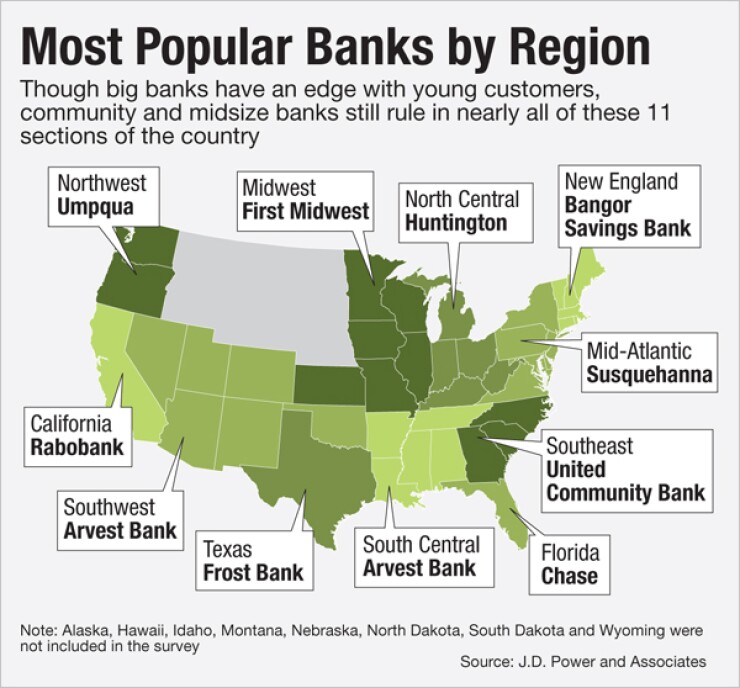-
But large banks have narrowed the gap as they have made a more concerted effort to better explain their fee structures to disgruntled customers.
April 18 -
The past year has seen gains in overall bank consumer satisfaction, but the news is decidedly mixed, according to J.D. Power's annual bank survey. Among the negatives: how the wealthy view banks in general and midsize institutions' falling popularity among minorities and millennials.
May 1 -
Fees on checking accounts continue to climb, especially at the largest banks, as free checking accounts slowly become an endangered species. But the price creep doesn't seem to have cost them customers.
February 24

The biggest banks still have a reputation problem, but their popularity among the youngest bank customers could be a source of hope and a worry for their smaller rivals.
Customers age 20 and younger were happier with the largest banks than with their regional and midsize rivals, according to J.D. Power's
The biggest banks' so-called Generation Z customers those born in 1995 or later have an average satisfaction rating of 807 out of 1000, nine points higher than regionals' and thirty-eight higher than mid-size banks'.
That generation younger than the much-ballyhooed millennials, who range from 21 to 38 under J.D. Power's definition prefers both the online and in-branch experience at the biggest banks, the study found. This represents a challenge for regional and community banks, which have traditionally been better at in-person customer service, said Jim Miller, J.D. Power's senior director of banking.
"The challenge for the midsize banks is as all these customers age, can they hold on to their advantage in customer service?" he said. "To some degree the smaller banks will always be behind on digital innovation."
J.D. Power classifies big banks as the six largest retail institutions (JPMorgan Chase, Bank of America, Wells Fargo, Citigroup, U.S. Bank and PNC), regionals as those with $33 billion to $180 billion in deposits and midsize as those with between $2 billion and $33 billion in deposits.
The survey, J.D. Power's 10th annual look at bank customer satisfaction, was the first to quantify the postmillennial generation's preferences. It surveyed 80,000 retail customers, age 18 and over, and covered banks with at least 50 branches.
Overall, members of the postmillennial generation like their banks more than older generations do. The average customer-satisfaction rating for "Generation Z" customers was 797, compared with a 790 average for all customers.
However, the rising generation's preference for megabanks is not shared by their elders. Smaller banks had the best scores in most parts of the country, and several of the biggest banks made notably poor showings. (J.D. Power provides regional rather than nationwide rankings, because average ratings vary widely across the country the average in Texas is 35 points higher than in New England, for instance.)
Out of eleven regions, a megabank ranked highest only in Florida, where JPMorgan Chase led with a satisfaction score of 834. It was on the whole the best performing large bank, with better-than-average scores in every region of its footprint.
By contrast, Bank of America was below average in all eleven regions, and was the lowest-rated bank in four. Citigroup was below average in each of its five regions, while Wells Fargo was ranked above average in seven regions and below average in four.
There was more good news for small banks in J.D. Power's mobile-banking numbers. The big banks' lead in mobile-banking satisfaction is narrowing, as features like mobile check deposit become common across the industry. There are even signs that big banks' mobile apps are becoming clunky: their scores for ease of use and clarity of information fell this year.
Mobile satisfaction fell six points for the big banks and was roughly flat for others. It was the first time mobile satisfaction declined since J.D. Power began tracking it in 2012.
"The challenge for the big banks is to make mobile still easy to use as they add new features," Miller said. "You don't want to be Microsoft and just keep adding features; you want the Apple approach of adding while making it easier to use."
Another surprise this year was customers' continued devotion to the branch -even among the youngest customers. Branch-use metrics have been stable for several years while mobile and online usage has risen, Miller said.
Branches are popular even with "Generation Z" customers, who used them at roughly the same rate as their older peers.
"The school of thought was that they don't ever go into the branch and you can meet all their needs digitally, but, at least today, that doesn't seem to be the case," he said. These customers "still feel more comfortable if they can go to a branch when they need it."
Overall, the average satisfaction rating of 790 was five points higher than
The modest improvement this year stems mostly from two factors: fewer complaints about poor service and less dissatisfaction about fees than last year. So to some degree, banks have simply been getting out of their own way and not frustrating their customers, Miller said.
"It's a case where doing nothing helps improve satisfaction," he said.
Certain banks stood out. Miller cited Comerica in Dallas (which improved by 18 points, to 796), Union Bank in San Francisco (15 points higher, to 798) and Citizens Bank in Providence, R.I., (nine points higher, to 779) as three that showed significant improvement from last year's survey.





